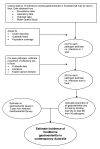Estimating foodborne gastroenteritis, Australia
- PMID: 16102316
- PMCID: PMC3320479
- DOI: 10.3201/eid1108.041367
Estimating foodborne gastroenteritis, Australia
Abstract
We estimated for Australia the number of cases, hospitalizations, and deaths due to foodborne gastroenteritis in a typical year, circa 2000. The total amount of infectious gastroenteritis was measured by using a national telephone survey. The foodborne proportion was estimated from Australian data on each of 16 pathogens. To account for uncertainty, we used simulation techniques to calculate 95% credibility intervals (CrI). The estimate of incidence of gastroenteritis in Australia is 17.2 million (95% confidence interval 14.5-19.9 million) cases per year. We estimate that 32% (95% CrI 24%-40%) are foodborne, which equals 0.3 (95% CrI 0.2-0.4) episodes per person, or 5.4 million (95% CrI 4.0-6.9 million) cases annually in Australia. Norovirus, enteropathogenic Escherichia coli, Campylobacter spp., and Salmonella spp. cause the most illnesses. In addition, foodborne gastroenteritis causes approximately 15,000 (95% CrI 11,000-18,000) hospitalizations and 80 (95% CrI 40-120) deaths annually. This study highlights global public health concerns about foodborne diseases and the need for standardized methods, including assessment of uncertainty, for international comparison.
Figures
References
-
- Hall GV, D'Souza RM, Kirk MD. Foodborne disease in the new millennium: out of the frying pan and into the fire? Med J Aust. 2002;177:614–8. - PubMed
-
- McMichael AJ, Haines A, Slooff R, Kovats S, eds. Change and human health. Geneva: World Health Organization; 1996.
Publication types
MeSH terms
LinkOut - more resources
Full Text Sources
Other Literature Sources
Medical
Miscellaneous


